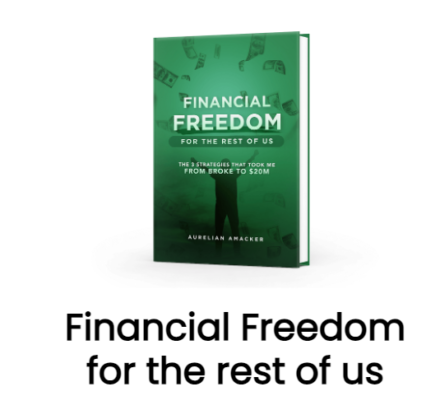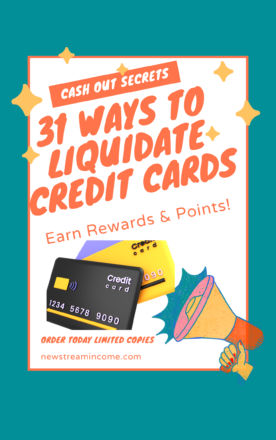Growing an engaged audience is crucial but challenging when starting a podcast or online business.
Chris Hutchins started the All the Hacks podcast in May 2021. Today, he reaches over 250,000 downloads per month and has released over 120+ episodes optimizing life, money, and travel and built other content to help listeners upgrade their lives.
In this episode, we’ll take a deep dive into Chris’s approach to growing his audience quickly and how you can apply similar tactics in your own business or side hustle.
Tune into episode 576 of The Side Hustle Show to learn:
How Chris gained traction in the podcasting space
Clever marketing tactics to grow your audience
Ideas for turning listeners into paying customers
Key mindsets for podcasting success
Chris’s #1 tip for side hustlers this year
Download Your Free Bonus: The Podcast Starter Kit
Get the free Podcast Starter Kit
The Side Hustle Nation guide to podcasting equipment and software, producing a quality show, growing your audience, and making money.
Sponsors
Notion – Try Notion AI for free!
HelloFresh — Use code sidehustle50 for 50% off plus free shipping on America’s #1 meal kit!
Ladder – Get instantly approved for term life insurance—no doctors, no needles, no paperwork!
Why Chris Chose Podcasting to Grow His Audience
When starting All the Hacks, Chris chose podcasting as his main platform despite the challenges with search and discovery compared to other options.
In the past, Chris had tried blogging and being active on multiple social media platforms without seeing much traction or success. He put in the effort creating content, but it just wasn’t taking off.
However, over the years, Chris had built up a strong personal reputation and established credibility by frequently appearing as a guest on other leading finance and lifestyle podcasts.
Chris realized his sweet spot was audio storytelling centered around optimizing major areas of life like personal growth, money, finances, travel hacking, and more.
These were topics that friends, colleagues, and acquaintances often picked his brain about in real life over dinners or casual conversations.
In Chris’s own words, “I’ve tried for many years to experiment with different platforms and it totally, totally failed. I love deals. I love optimizing life, money, travel, and that’s been my brand amongst friends.”
People seemed to really value his advice and perspectives on living an optimized life. And with podcasting, he could share his insights with a much wider audience of people interested in those same things.
The key factor that made the difference was consistency. Chris made a firm commitment to publish one episode per week without missing any.
As he put it, “I said I am committing to release an episode every Wednesday, and I just committed to it, and I haven’t missed one since.”
Initially, he told himself he would try recording and releasing at least 8 episodes and see how it went. But by the time he got to Episode 3, Chris knew in his gut that podcasting was the right medium and format for him.
All the Hacks’ Broad Appeal
At first glance, the idea of a show helping you “optimize all aspects of your life” seems extremely broad. It is counter to the common advice of “niching down and focusing on a targeted audience.”
Not only that, but it’s a concept numerous other podcasters and influencers have likely attempted to build content around before. So on the surface, it may appear challenging to stand out.
Yet it worked remarkably well for All the Hacks.
Why is that?
According to Chris: “The idea was, the niche is that people who like to optimize their lives, which you could argue is a lot of people, but I think when you kind of break it down, some people are just really content not optimizing their lives.”
So while the topic is broad, Chris realized there is still a sizable audience segment who actively enjoys the process of optimizing and improving major parts of their life.
As an avid lifelong optimizer himself, Chris speaks authentically on a wide range of topics. He doesn’t pretend expertise where he has none. The advice comes from real experience testing principles in his own life.
And as Chris noted, “I think part of why it worked was that I was trying to not to go niche on a type of a personality, but not a type of topic.”
Applying the 80/20 rule, you gain more knowledge by diversifying instead of going ridiculously deep into one narrow niche. This variety allowed the show to touch on different areas of life optimization while engaging listeners.
So in summary, while ultra-targeted shows may thrive, Chris leveraged his genuine passion for optimization along with a broad but engaged listener base interested in upping their game in different aspects of life.
Hacks Chris Used to Rapidly Grow His Audience
In the early days of All the Hacks, Chris meticulously tested many different marketing tactics and approaches to build his audience. He tried a lot of things, tracked the data, and doubled down on what delivered results.
Here are some of the strategies that proved most effective for rapidly growing his listenership:
Tapping Into Existing Audiences
Once Chris had a few episodes recorded, he called in every favor and connection he had made, even if those people only had relatively small followings themselves. As he explained:
“I called in every favor. I told everyone I know, can you share this thing? I knew one day I would want to launch something that I asked for people to help with.”
Getting his podcast in front of these other engaged audiences generated significant momentum and a vital initial base of subscribers. It provided the spark to kickstart the flywheel effect.
Chris was also very aggressive about pursuing opportunities to guest on other related podcasts with built-in audiences aligned to his topics of optimizing life, finance, travel and more.
He estimates this guest appearance approach typically converts around 3-4% of the host’s audience into regular listeners of his show.
On the other hand, he found simple promotional swaps where he exchanged ads or mentions with other podcasters tended to only convert around 0.5-1% on average.
So being a guest rather than just doing a promo swap generated 5-10x more new listeners from each appearance. The key is finding podcasts with a relevant audience and bringing tons of value as a guest.
Have Multiple Episodes at Launch
When Chris finally did launch, he made 3 full episodes available immediately instead of just releasing the first episode alone.
Having multiple episodes out there initially allowed new listeners to get a much better sense of the show’s full range and variety of topics right off the bat.
If he had only launched with Episode 1 focusing on a single theme, some people may have gotten the wrong idea about the show’s scope.
Chris also stresses the critical importance of having a “trailer” or some kind of short, compelling preview video that quickly communicates the essence of your show.
As he notes: “You want to make sure it’s easy for people to find all this content. So I think that’s one way to build that excited, passionate, loyal listener base who is going to recommend your show to their friends and ask that.”
Test Paid Ads
Once the show was more established after a few months, Chris did a small budget of $100-200 advertising tests on niche podcast apps like Overcast and SparkLoop.
He found the strong results—both the clickthrough rate and, more importantly, the subscriber conversion rate—validated the wide appeal of his content.
As Chris explained, “What that told me is, compared to the average show, the title, the description, the cover art is probably about average. It got about the number of clicks they expected. Maybe on the high end of average. But the number of people that subscribed is 2x what they saw. Which made me feel like, wow, I have content people like.”
Micro-experiments like these provide concrete validation when you’re just starting out.
Try Grassroots Marketing
In the spirit of testing everything, Chris tried some creative guerrilla marketing tactics that ended up working surprisingly well.
For instance, he put a link and blurb about the All the Hacks podcast in his default email signature. Incredibly, this led to some new listeners who didn’t even realize it was an ad; they assumed Chris was just personally recommending the show!
The key takeaway is you have to get innovative about finding opportunities to spread the word everywhere you go. You never know what unconventional marketing tactic could drive a few listeners your way until you give it a shot.
Engage Your True Fans
Once Chris had a solid baseline audience, he started focusing more on engaging and retaining his most avid listeners to keep growing organically.
For example, he includes thorough show notes for each episode highlighting:
key resources
relevant links
time-stamped chapter markers.
This caters to fans who want to dig deeper into the content.
He also proactively asks loyal listeners to leave reviews and solicits feedback through surveys. This helps him keep improving the show and create more of the content they value most.
When Chris asks about other podcasts or blogs his audience follows, he can identify overlapping niches and potential partners or collaborators to work with. It reveals opportunities.
The takeaway here is once you have a core audience built up, you need to engage them, understand them, and optimize your content for those true fans. This helps sustain organic growth through word of mouth as they share the content they love.
Making the Leap to Full-Time
It took longer than it should have by Chris’s own admission, but he eventually transitioned All The Hacks into a full-time business.
Rather than focusing on the loss of his salary, he framed it as a 6-month experiment. Between saving up and already earning more from the podcast than his day job, it became feasible to take the leap.
Now Chris’s wife is leaving her job as well to work on All The Hacks. As Chris said, “It means we have no more stable income and entire creator income life. But we just felt like we had to do it, so it felt right.”
Monetization
For the first several months, like most creators, Chris focused entirely on building his audience and improving the content. But over time, he has steadily incorporated multiple streams of revenue.
Advertising
Chris estimates each listener is worth approximately $2-4 per year in ad revenue based on his calculations. So it only makes sense to buy listeners via ads if the cost is lower. Typically, a show needs at least 10k-20k downloads per episode for ads to become a viable revenue stream.
In his own words: “I typically think that you cross a threshold where the advertiser is spending $1,000 per episode to advertise, and it starts to become interesting. But to get to $1000 an episode at even a $20 CPM means you need almost 50,000 downloads.”
Affiliates
Promoting products, services, software tools, and credit card links his audience finds valuable earns commissions while providing a helpful service. These partnerships earn income more easily than ads early on in a show’s lifespan.
Membership
For $19/month or $99/year, the All the Hacks membership offers:
Exclusive deals and discounts on brands relevant to “life optimizers”
Monthly community calls
Private Q&As and access to Chris
Full archive of calls and show content
So far, over 300 passionate supporters have signed up. Chris sees this as similar to AARP but for millennials.
Digital Products
Sell tools and resources your audience needs—for Chris, this has included his credit card optimization spreadsheet. He is also building a comprehensive course on travel hacking.
Coaching
One-on-one consulting for people serious about starting a podcast or building their brand using his expertise.
Speaking
Paid talks at companies, conferences, or organizations about topics related to the show and Chris’s knowledge base.
Growth Hacks to Attract More Listeners
When it comes to attracting more podcast listeners over time, Chris relies on several go-to strategies:
Guesting on other shows, especially those catering to his target audience of optimizers and deal finders
Promo swaps with other podcasters to cross-promote and share audiences
Optimizing his show notes by adding chapters and links to provide value and build loyalty
Asking niche fans to leave reviews to help validate the show to prospective listeners
Monitoring the news and trends for timely episode topics to tap into search demand
Including a clear podcast recommendation in all emails and communications
What’s Next for All The Hacks?
Now that the podcast is established, Chris is looking to further grow his audience by adapting the content for more platforms:
Repackaging podcast content into newsletters instead of mere transcripts
Creating videos optimized specifically for YouTube, Instagram, TikTok
Turning audio content into visual social posts ideal for Twitter (now X), LinkedIn
He plans to hire freelancers to help adapt the content in ways native to each platform.
But again, Chris emphasized following your own curiosity and excitement above all else. That genuine interest will drive longevity and creativity more than chasing any specific opportunity.
Key Takeaways
Chris’s journey growing All the Hacks provides several digestible but powerful tips you can apply in your own business:
Leverage Existing Audiences
Focus on Consistency
Commit to One Platform
Validate with Testing
Engage True Fans
Diversify Monetization
Chris’ #1 Tip for Side Hustle Nation
“Follow your curiosity.”
Links and Resources from this Episode
Episode 478: 33 Life Hacks to Experiment With in 2022 – Mission: Optimize Everything, with Chris Hutchins
All the Hacks
Overcast
SparkLoop
Looking for More Side Hustle Help?
Start Your Free $500 Challenge. My free 5-day email course shows you how to add $500 to your bottom line.
Join the free Side Hustle Nation Community. The free Facebook group is the best place to connect with other side hustlers and get your questions answered.
Download The Side Hustle Show. My free podcast shares how to make extra money with actionable weekly episodes.


















